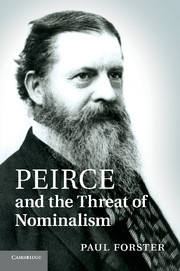Book contents
- Frontmatter
- Contents
- Preface
- List of abbreviations
- 1 Nominalism as demonic doctrine
- 2 Logic, philosophy and the special sciences
- 3 Continuity and the problem of universals
- 4 Continuity and meaning: Peirce's pragmatic maxim
- 5 Logical foundations of Peirce's pragmatic maxim
- 6 Experience and its role in inquiry
- 7 Inquiry as self-corrective
- 8 Theories of truth: Peirce versus the nominalists
- 9 Order out of chaos: Peirce's evolutionary cosmology
- 10 A universe of chance: foundations of Peirce's indeterminism
- 11 From inquiry to ethics: the pursuit of truth as moral ideal
- Bibliography
- Index
5 - Logical foundations of Peirce's pragmatic maxim
Published online by Cambridge University Press: 28 April 2011
- Frontmatter
- Contents
- Preface
- List of abbreviations
- 1 Nominalism as demonic doctrine
- 2 Logic, philosophy and the special sciences
- 3 Continuity and the problem of universals
- 4 Continuity and meaning: Peirce's pragmatic maxim
- 5 Logical foundations of Peirce's pragmatic maxim
- 6 Experience and its role in inquiry
- 7 Inquiry as self-corrective
- 8 Theories of truth: Peirce versus the nominalists
- 9 Order out of chaos: Peirce's evolutionary cosmology
- 10 A universe of chance: foundations of Peirce's indeterminism
- 11 From inquiry to ethics: the pursuit of truth as moral ideal
- Bibliography
- Index
Summary
In the previous chapter I explained why Peirce thinks his pragmatic maxim contradicts the nominalist theory of cognitive content. According to the maxim, I noted, the meaning of a cognitive sign is explicated by conditionals that imply lawful relations between certain actions and their consequences and the content of these conditionals cannot be reduced to claims about individuals, as the nominalist theory requires. However, I did not give Peirce's reasons for thinking that the pragmatic maxim is true. In the absence of a compelling argument for the maxim, he would admit that appealing to it as grounds for rejecting the nominalist theory of meaning is question-begging.
Despite the importance of the pragmatic maxim for Peirce's critique of nominalism, it remains unclear how it is to be established. In his best-known defence of it, in ‘How to Make Our Ideas Clear’, he draws on a conception of inquiry developed in light of discoveries in the behavioural sciences. On the view he sketches, cognition is a biological process aimed at acquiring reliable ways of acting in the world. Stimuli that confound an organism's habitual responses yield hesitant or ‘doubtful’ reactions. The search for a course of action appropriate to an uncertain situation – what Peirce calls ‘inquiry’ – terminates in behaviour that is adequate to the circumstances and, as a result, more likely to be repeated given similar conditions in the future.
- Type
- Chapter
- Information
- Peirce and the Threat of Nominalism , pp. 78 - 107Publisher: Cambridge University PressPrint publication year: 2011



